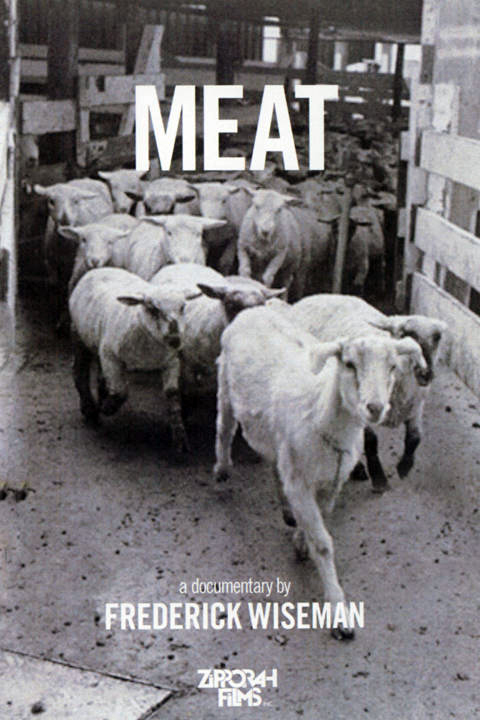 The most fearsome and notorious Frederick Wiseman documentary of them all. Wiseman certainly made some notorious documentaries in his time, such as the insane asylum set TITICUT FOLLIES (1967), the police follow-along LAW AND ORDER (1969) and the scientific research expose PRIMATE (1974), but this 1975 depiction of the inner workings of meat packing plants outdoes all three in ugliness and outrage. It also outdoes the other major slaughterhouse doco, Georges Franju’s 1949 short BLOOD OF THE BEASTS; MEAT, by contrast, takes its time, giving us a full accounting of the business of meat.
The most fearsome and notorious Frederick Wiseman documentary of them all. Wiseman certainly made some notorious documentaries in his time, such as the insane asylum set TITICUT FOLLIES (1967), the police follow-along LAW AND ORDER (1969) and the scientific research expose PRIMATE (1974), but this 1975 depiction of the inner workings of meat packing plants outdoes all three in ugliness and outrage. It also outdoes the other major slaughterhouse doco, Georges Franju’s 1949 short BLOOD OF THE BEASTS; MEAT, by contrast, takes its time, giving us a full accounting of the business of meat.
The film’s power is evident in the fact that it’s been effectively banned from public exhibition by beef industry lobbyists (although it was screened on PBS, and released on DVD and VOD by Wiseman himself). Tracking it down is essential for anyone with an interest in just how meat gets from the slaughterhouse to the dinner table, but be forewarned: it’s a rough ride.
Filmed, like most of Wiseman’s early work, in grainy 16mm black and white, it begins with several dozen cows being packed into a truck and taken to auction. From there we see the critters in a feed lot, where they’re branded and allowed to graze in vast corn-filled troughs (with exposition imparted via a group of Asian tourists being shown around the area by a nervous employee). As marketing men in cozy offices make beef shipment deals with unseen phone callers the cows are herded into a slaughterhouse, where they’re killed, stuck on hooks and undergo an orgy of skinning and gutting. We follow the carcasses as they’re subjected to further bouts of chopping and plucking, until all that’s left are bite-sized chunks.
We then look in on another meat processing plant, where sheep are dispassionately shorn of their fur. They, it transpires, are the lucky ones, with their less fortunate fellows led by a “Judas goat” into a slaughterhouse. There the animals are killed via electric shocks to the head, and their carcasses subjected to roughly the same process as the slaughtered cows we just saw.
Following a lengthy cutaway depicting an argument between plant managers and supervisors over the division of labor, and a discussion about the possibility of a shortage of beef (which is apparently destined to become a “luxury item”), we see the final stage of the meat’s journey: as ground-up hamburger patties and chunks of steak that are packaged, boxed and loaded into the back of a truck that’s in route to a supermarket.
In depicting MEAT’s horrors Wiseman, as was his wont, doesn’t bother with music or narration, with only the ambient sounds of the slaughterhouse (consisting of machines humming and miscellaneous chatter) keeping us company on the soundtrack. Opposing these scenes are those set in quiet, comfortably furnished reception and meeting rooms, where the plant’s managers, supervisors and salesmen wheel, deal, bicker and at one point dispassionately discuss all the cattle that have died.
Wiseman’s uncanny talent for getting his subjects to “perform” without any evident artifice is on full display in MEAT, which contains some of his most memorable images. The opening scene of horse riding men corralling cows, which appears straight out of a Hollywood western, is one especially striking sight. Others include that of workers hosing down the slaughterhouse floor and of the stripped-clean cow carcasses being tagged and stamped, a sight I found even more upsetting than the bloodletting and innard pulling. The black and white photography keeps the unpleasantness at bay somewhat (Wiseman, it seems, was pioneering the muted color value device that subsequent films like TAXI DRIVER and KILL BILL have used to placate squeamish audiences), but the appallingly impersonal, assembly line nature of the slaughter is impossible to ignore, much less forget.
Vital Statistics
MEAT
Kine Films, Inc.
Director/Producer/Editor: Frederick Wiseman
Cinematography: William Brayne
